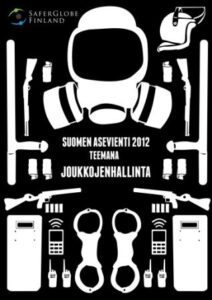SaferGlobe Research Network
Release 12/9/2013
In 2012, more military equipment were exported from Finland than in any other year this decade. The exports were altogether worth of 113 million euros. The exports of military equipment increased 30 percent in the five year period of 2008-2012 when compared to the previous five year period (2003-2007). As individual sales can have a significant statistical impact, arms export is analyzed in five-year periods.

The global trade in arms fell by half a percent but, for example, the exports of Europen Union´s largest arms exporters remained stable. According to the Stockholm Peace Research Insitute SIPRI, the worlds´s main arms importers at the moment are Asian and Middle-Eastern States such as India, China, Pakistan, South Korea, Singapore, the United Arab Emirates and Saudi-Arabia. The balance of power in armaments seems to be moving to Asia. For the first time since the Second World War, Great Britain is not included among the five largest arms exporters after being replaced by China.
Finland approved 208 military export licence applications. The Finnish Government approved three of them. The most significant one was the export licence for a sale of a manufacturing licence for Patria’s AMV-vehicles into Poland. . Half of the sales in military equipment went to EU countries, which means volume of sales increased from 43 percent to 50 percent. This shows that the current financial crisis is not yet affecting Finland’s share in EU’s arms purchaces.
In 2012, three export licence applications were declined, giving clear indication that overall considerations are significant when granting export licences. Based on the political risk analysis of the Ministry for Foreign Affairs, some export licences were declined for arms export to for example Saudi-Arabia and Bahrain. In contrast, the export of military ammunitions to Turkey, which is preparing for potential reprocussions of the Syrian civil war grew. Likewise a export licence was granted to 150 sniper rifles to Kuwait.
In the previous Arms Trade Report, we reported that in the autumn of 2010, an export license was granted to over two hundred sniper rifles to Bahrain. In the official export statistics of the Defence Ministry, Finland only reported an export license for 870 000 euros worth of rifles, and failed to report the remainder of the 3,5 million euro arms cargo.
In the report we analyse the transparency of arms trade. Our theme for this year is crowd control. It is an important part of Finland’s military crisis management and it has played an important role in the crisis management operation in Kosovo. In addition we analyse the national and international rules and regulations that govern the actions of authorities in crowd control situations.
Altogether 150 721 commercial fire-arms or civilian firearms were given an export licence. According to the export licences the export of arms decreased by 18,5 percent in the five year period 2008-2012 compared to 2003-2007. The real volume of exports is unknown because it is not monitored by the authorities. The Finnish system is lacking in transparency because both civilian and military arms are included in the same customs regulations. Out of specific countries the exports to Namibia grew the most with export licences for 5 200 rifles being approved. Because the export licences for civilian firearms are not public, it is not known if the licences were for tradional hunting weapons or for example semi-automatic military weapons.
130,4 million civilian cartridges were granted an export licence during the year 2012. When talking about civilian cartridges one has to take into account that for example the ammunition for the snipers in the Bahraini armed forces were exported under the label of civilian cartridges. Judging by the export licences the volume of exports dropped by 11,4 percent in the five year period between 2008-2012 compared to 2003-2007. The real volume of exports is unknown because the authorities do not keep track of it.
For dual-use technology, altogether 434 export licences were granted, 30 percent more than last year. Dual-use technology can be used for weapons of mass destruction or instead civilian use for military purposes. The most significant change was seen in South America which share of Finnish exports grown from three percent to 13 percent. The growth came from exports to Brazil and Mexico.
Suomen asevienti 2012 – Teemana joukkojenhallinta. Johannes Lehtinen (Eds.). SaferGlobe Finland, 2013. Pages 28. The report can be ordered from our webstore.
